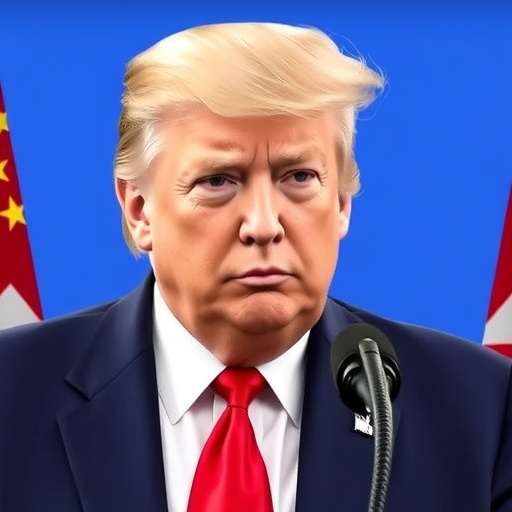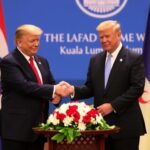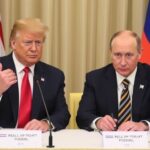Trump Issues Ultimatum: 155% China Tariff Looms if Trade Deal Misses November 1 Deadline
In a bold escalation of the ongoing trade war, President Donald Trump has threatened to impose a staggering 155% tariff on Chinese imports if no comprehensive trade deal is reached by November 1. This dramatic warning comes just as the United States inks a landmark billion-dollar agreement with Australia to secure critical minerals, aiming to wean off dependency on Chinese supplies and reshape global supply chains.
The announcement, delivered during a White House press briefing on Thursday, underscores the intensifying pressure on Beijing to concede on key issues like intellectual property theft, forced technology transfers, and market access barriers. Trump, speaking to reporters, stated, “If China doesn’t come to the table with a fair deal by November 1, they’ll face tariffs like they’ve never seen—155% on everything from electronics to steel. We’re done playing games.” This move signals a potential turning point in the protracted US-China trade negotiations that have rattled global markets for over two years.
Market analysts are already bracing for volatility. The Dow Jones Industrial Average dipped 1.2% in early trading following the remarks, with tech stocks—particularly those reliant on Chinese manufacturing—taking the hardest hit. Apple’s shares fell 2.5%, while semiconductor firms like Qualcomm saw declines of up to 3%. Economists warn that such tariffs could add hundreds of billions to the cost of goods for American consumers and businesses, potentially fueling inflation at a time when the US economy is showing signs of recovery post-pandemic.
US-Australia Pact Targets China’s Mineral Monopoly
Parallel to Trump’s tariff threat, the US has solidified its strategic partnership with Australia through a $1.2 billion deal focused on critical minerals. This agreement, signed in Canberra by US Secretary of Commerce Wilbur Ross and Australian Trade Minister Dan Tehan, commits to joint investment in mining and processing of rare earth elements, lithium, and cobalt—minerals essential for electric vehicles, renewable energy tech, and defense applications.
Australia, home to the world’s largest reserves of lithium and a major producer of rare earths, emerges as a key ally in diversifying supply chains away from China, which currently controls over 80% of global rare earth processing and 60% of lithium production. Under the deal, the US will provide $500 million in funding for Australian mining projects, while Australia pledges to fast-track exports of processed minerals to American firms. “This partnership isn’t just about trade; it’s about national security,” Ross emphasized during the signing ceremony. “We can’t afford to let China hold the world’s green energy transition hostage.”
The initiative builds on the 2020 US-Australia Critical Minerals Taskforce, which identified supply vulnerabilities exacerbated by the COVID-19 disruptions. For instance, in 2021, global shortages of semiconductors traced back to rare earth constraints delayed US auto production by millions of units, costing the industry an estimated $210 billion. By partnering with Australia, the US aims to ramp up domestic processing capacity, potentially creating 10,000 jobs in states like Nevada and Texas, where new facilities are planned.
Environmental considerations are woven into the pact, with both nations committing to sustainable mining practices. Australia’s Lynas Corporation, a leading rare earth producer, will receive US grants to expand its Mount Weld mine while adhering to stricter carbon emission standards. This move not only counters China’s dominance but also aligns with Biden administration priorities—wait, no, under Trump—on energy independence, though critics argue it overlooks the human rights issues in Australian indigenous lands.
Escalating Tensions: The Road to November 1 Deadline
The November 1 deadline isn’t arbitrary; it ties into the expiration of the current Phase One trade deal signed in January 2020, which required China to purchase $200 billion in US goods but fell short by 40%, according to US Trade Representative Robert Lighthizer. Trump has repeatedly lambasted Beijing for non-compliance, citing data from the Peterson Institute for International Economics that shows Chinese purchases of American soybeans and energy products lagging behind commitments by $100 billion.
Negotiations have been rocky, with virtual talks in recent months yielding little progress. A senior White House official, speaking anonymously, revealed that the US is demanding structural reforms, including an end to subsidies for state-owned enterprises that distort markets. China, in turn, accuses the US of protectionism, with state media like Xinhua labeling the tariff threat as “economic bullying.” Recent tit-for-tat measures include China’s imposition of anti-dumping duties on US chemicals, escalating the rhetoric.
Statistics paint a grim picture of the stakes. The US imported $540 billion in goods from China in 2022, per US Census Bureau data, supporting over 1 million American jobs but also contributing to a $355 billion trade deficit. A 155% tariff—up from the current 25% on many items—could slash imports by 50%, according to a Moody’s Analytics forecast, but at the cost of $1,200 annually per US household in higher prices. Industries like apparel and consumer electronics, which source 70% of components from China, face existential threats.
Trump’s strategy appears to leverage the tariff threat as a bargaining chip, reminiscent of his 2018 tactics that led to the Phase One agreement. However, with midterm elections looming, political pressures mount. Republican senators from farm states, hit hard by retaliatory tariffs, have urged caution, while Democrats decry the approach as reckless. Senate Minority Leader Chuck Schumer tweeted, “Trump’s tariff tantrums risk another recession—time for real diplomacy, not bluster.”
Global Markets Brace for Trade War Shockwaves
The threat of a 155% China tariff has sent ripples across international markets, with commodity prices surging and currencies fluctuating. The Australian dollar strengthened 1.5% against the USD on news of the minerals deal, reflecting investor confidence in diversified supply chains. Meanwhile, the Chinese yuan weakened to a 16-month low, prompting Beijing’s central bank to intervene with $20 billion in liquidity injections.
European allies are watching closely. The EU, which relies on China for 98% of its rare earths, is exploring similar pacts with Australia and Canada. A report from the European Commission estimates that US tariffs could disrupt $150 billion in transatlantic trade if supply chains reroute through Europe. In Asia, Japan and South Korea—key US partners—have accelerated their own decoupling efforts, with Tokyo investing $2 billion in domestic battery production to bypass Chinese lithium.
Expert voices highlight the broader implications. Dr. Emily Chen, a trade economist at the Brookings Institution, notes, “This isn’t just about tariffs; it’s a geopolitical pivot. By allying with Australia on critical minerals, the US is building a ‘minerals NATO’ to counter China’s Belt and Road dominance.” Conversely, Peter Navarro, Trump’s former trade advisor, defends the hardline stance: “China’s been ripping us off for decades. A 155% tariff is the wake-up call they need.”
Domestic impacts are equally profound. US manufacturers, via the National Association of Manufacturers, warn of 500,000 potential job losses if tariffs spike, though proponents argue long-term gains from reshoring. The agriculture sector, scarred by $27 billion in lost exports since 2018, eyes the deadline warily, with corn and pork prices volatile amid fears of renewed Chinese retaliation.
Strategic Shifts: Reshaping Alliances and Supply Chains
Beyond immediate tariffs, the US-Australia critical minerals deal signals a broader realignment in global trade architecture. The agreement includes provisions for technology sharing, such as US expertise in advanced refining techniques, which could boost Australia’s export value by 30% within five years, per government projections. Key projects include a $300 million joint venture for a cobalt processing plant in Western Australia, set to supply Tesla and GM by 2024.
This diversification effort addresses vulnerabilities exposed by recent events. During the 2022 energy crunch, Chinese export restrictions on gallium and germanium—vital for chips—drove prices up 200%, hampering US defense contractors like Lockheed Martin. The new pact aims to secure 20% of US critical mineral needs from Australia by 2030, reducing China’s leverage in potential conflicts over Taiwan or the South China Sea.
Stakeholders in the green energy sector applaud the move. The International Energy Agency forecasts demand for lithium tripling by 2030 to support 700 million electric vehicles, making supply security paramount. “Australia’s stable democracy and vast resources make it the ideal partner,” says Liam Fitzsimmons, CEO of US-based Albemarle Corporation, a major lithium producer collaborating on the deal.
Challenges remain, however. Logistical hurdles, such as shipping delays through the Panama Canal, could inflate costs by 15%. Environmental groups like Greenpeace criticize the rush to mining, citing risks to Australia’s Great Barrier Reef from runoff. Nonetheless, the initiative positions both nations as leaders in the clean energy race, potentially attracting $5 billion in private investment.
Looking Ahead: Pathways to Deal or Disruption
As the November 1 deadline approaches, all eyes are on upcoming trade talks scheduled for late October in Geneva. US negotiators, led by Lighthizer, seek commitments on agricultural access and currency manipulation, while China pushes for tariff rollbacks. Failure to agree could trigger phased tariff increases, starting at 50% and ramping to 155%, per White House outlines.
Optimists point to backchannel diplomacy, including recent calls between Trump and Xi Jinping, as harbingers of compromise. A partial deal on critical minerals—ironically mirroring the US-Australia pact—could emerge, allowing China to retain some market share. Pessimists, however, foresee a prolonged standoff, with WTO disputes piling up and global growth shaved by 0.5%, according to IMF projections.
For American businesses, the path forward involves hedging bets: stockpiling imports, scouting alternatives in Vietnam and Mexico, and lobbying for subsidies under the CHIPS Act. Consumers may face sticker shock on everything from iPhones to EVs, but proponents argue the pain paves the way for a more resilient economy. In this high-stakes game, Trump’s tariff threat and the Australia alliance could either forge a new trade equilibrium or ignite the most disruptive chapter yet in US-China relations.










